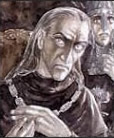HARUKI MURAKAMI Link #4

Though this is no Yukio Mishima we’re dealing with here: no haunting images of cherry blossoms, no elegies on honorable samurais and on the frailty of ephemeral life, no geishas and delicate Japanese painting landscapes flooding his works. Murakami confesses, through a number of his characters, that he’s not particularly fond of Japanese literature, nor does he find in it what he’s looking for. His controversial generation needed a different kind of literature, and so his writings are meant for the teenage upbeat punkers, the sophisticated and cynical young urban artists, the millions of regular young people populating modern Japan who love anime, video games, and rock, who shriek at the “Return of the King” premiere and howl in delight as hard-boiled “Harriipottaa” fans.
Murakami’s characters are clumsy, hypersensitive teenagers fumbling with their first love affairs (“Norwegian Wood”, “Kafka on the Shore”), lonely misfits yearning for companionship and looking for an escape in hallucinatory alternative worlds (“Sputnik Sweetheart”, “A Wild Sheep Chase”, “Honey Pie”), talking cats, crows and toads sporting quotes from Dostoyevsky and other Russian “heavies”, depressed lawn-mowers and pushy, overconfident and sophisticated young girls harboring romantic souls. Perhaps the best way to catch a glimpse of Murakami’s universe and relate to it on a personal level is through his own words, with the voice of the narrator in “Hear the Wind Sing”: “If it’s art or literature you’re looking for, you’d do well to read the Greeks. In order for there to be true art, there necessarily has to be slavery. That’s how it was with the ancient Greeks: while the slaves worked the fields, prepared the meals and rowed the ships, the citizens would bask beneath the Mediterranean sun, rapt in poetical composition or engaged in their mathematics. That’s how it is with art. Mere humans who root through their refrigerators at three o’clock in the morning can only produce writing that matches what they do. And that includes me.”
He has preserved this self-deprecating quality in the face of overwhelming material success following his first best-seller “Norwegian Wood” (named after the famous Beatles hit), along with a cool, seemingly detached tone and an offbeat sense of humor. He never plans his work beforehand, never frets over plot and character building, and never sees beyond the page he’s writing. In a sense, he’s having as much fun writing his novels and short stories as his audience will when reading them. Whenever immersed in one of Murakami’s works, you never feel the presence of an over-bearing author, who already knows what’s going to happen next, who is a control freak and smirks at your toil. He’s spontaneous, as much amazed by the plot development as you are, and has a distinctive likeness for rhythm, for a sort of hidden melody within each story: “But that’s the fun of writing a novel or a story, because I don’t know what’s going to happen next. I’m searching for melody after melody. Sometimes once I start, I can’t stop. It’s just like spring water. It comes out so naturally, so easily.”
His great friend and admirer, Kazuo Ishiguro (Booker Prize winner for the well-known “Remains of the Day”) is perhaps the closest to understanding and enjoying Haruki Murakami’s style and personality: “He has two distinct styles. There’s the bizarre, anarchic style and there’s the very controlled, melancholy approach. Of the latter, “South of the Border” is beautifully judged, so fragile. It’s almost like a piece of cocktail jazz you hear playing in a bar, a perfectly measured piece from beginning to end. On the other side is “The Wind-up Bird Chronicle”, the berserkly inventive side where he keeps hitting you with things and you’re not quite sure what to do with them.”
So if you’re in the mood for intensely alive, brooding characters, bizarre events and surrealistic landscapes, permeating music themes and an unmistakable rhythm, just try one of his short stories and novels. You’ll soon become addicted, as addicted as he is to jazz; when asked which three albums, out of several thousand, would he save if his house were burning, he replied: “I give up. I couldn’t choose three. So I let it burn. Everything. I save the cat.”
Born: January 12, 1949; Kyoto.
Educated: Waseda University, Tokyo.
Married: 1971 Yoko Takahashi.
Career : 1974-1981: owner of Peter Cat jazz club, Tokyo. 1984: visits US. 1986-89: lives in Europe. 1991-1995: lives in US. 1991-93: visiting scholar at Princeton University. 1992: Una’s Lecturer in the Humanities at UC Berkeley. 1993-1995: writer in residence at Tufts University, Medford, Massachusetts. 1995: returns to Japan.
Novels: Hear the Wind Sing (1979, translated 1987); Pinball 1973, (1980, translated 1985); A Wild Sheep Chase (1982, translated 1989); Hard-Boiled Wonderland and the End of the World (1985, translated 1991); Norwegian Wood, (1987, translated 1989); Dance Dance Dance, 1988, translated 1994); South of the Border, West of the Sun (1992, translated 1999); The Wind-up Bird Chronicle, (1994-95, translated 1997); Sputnik Sweetheart, 1999, translated 2001); Ubime no Kafka (2003, translated & published as “Kafka on the Shore” 2005).
Collections of Stories: The Elephant Vanishes (1993); After the Quake (2000, translated 2002).
Non-fiction: Portraits in Jazz 1 and 2 (1997 and 2001); Underground, (1997 and 1998, translated 2000); and others.
Essays: Murakami’s House of the Rising Sun (1984); A Young Reader’s Guide to Short Fiction (1997); and others.
Some honours and awards: Noma Literary Newcomer’s Prize (1982, for A Wild Sheep Chase); Tanizaki Literary Prize (1985, for Hard-Boiled Wonderland and the End of the World); Yomiuri Literary Prize (1995, for The Wind-up Bird Chronicle); Kuwabara Takeo Prize (1999, for Underground).









